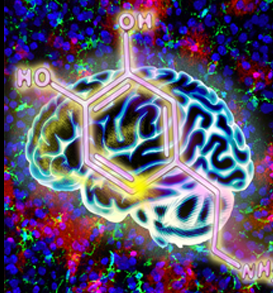
A recent study analyzed the genomic, behavioral, multi-channel EEG and functional MRI data of transgenic macaque monkeys, and found that MECP2 gene overexpression caused a chain of functional changes in GABA signaling pathway, β band neural synchronization, functional connectivity networks and cognitive behaviors. This work was performed by researchers in Dr. WANG Zheng’s lab. Furthermore, it identified that abnormalities of functional connectivity networks in transgenic macaques were similar to those of a subgroup of autism patients.

A recent study published in PLOS Biology revealed that light-dark cycle is essential for the initiation of the cellular clock in zebrafish by constructing a transgenic zebrafish line to report in vivo circadian rhythm at the single-cell level. This work was performed by researchers in Dr. YAN Jun’s Lab and Dr. HE Jie’s lab at the Center for Excellence in Brain Science and Intelligence Technology, Chinese Academy of Sciences in collaboration with Dr. LI Yuanhai at First Affiliated Hospital of AnHui Medical University.

A recent study published in Neuron provided new evidence about the neural mechanisms of active information maintenance in working memory. The work was performed by the researchers in Dr. LI Chengyu’s Lab. This work strongly supported the critical role of transient coding scheme, but not persistent coding scheme, in WM information maintenance under the current experimental conditions.

A recent study published in Nature reported two conserved epigenetic regulators as novel anti-aging targets. This work was performed by researchers in Dr. CAI Shiqing’s Lab at the Center for Excellence in Brain Science and Intelligence Technology, Institute of Neuroscience, State Key Laboratory of Neuroscience, Chinese Academy of Sciences, and Dr. JIANG Lubing’s team at the CAS Key Laboratory of Molecular Virology and Immunology, Institut Pasteur of Shanghai, Chinese Academy of Sciences. The work has unraveled conserved negative regulators of healthy aging by using multiple modalities and systems, providing insights into how to achieve healthy aging.

A recent study published in Nature Neuroscience revealed the spatiotemporal gene expression pattern in mammalian circadian pacemaker, Suprachiasmatic Nucleus (SCN), at single-cell resolution. This work was performed by researchers in Dr. YAN Jun’s Lab. The understanding of neuronal mechanism of circadian rhythm in nervous system is important for the human health.

A recent study published on eLife, focusing on deep and bulk transcriptomic analysis of spiral ganglion neurons (SGNs) in mouse inner ear, is performed by researchers in Dr. LIU Zhiyong’s Lab. Therefore, how to maintain functions of SGN and regenerate them after the damage is one important but tough question in the hearing field.

A recent study published in Journal of Neuroscience reveals a new pro- inflammatory factor pancreatitis-associated protein-I (PAP-I) in maintaining neuropathic pain. This work was performed by researchers in Dr. ZHANG Xu’s Lab and in Dr. BAO Lan’s Lab.

A recent study published in PNAS reveals the circuit mechanisms of inhibitory synaptic control of spinal GRPR+ neurons. This work was performed by researchers in Dr. SUN Yangang’s Lab. This work entitled “Synaptic control of spinal GRPR+ neurons by local and long-range inhibitory inputs” was published online in PNAS on Dec. 5, 2019.

On November 27th, 2019, a symposium on frontiers of neuroscience was held at the “320 campus” in honor of the 20th anniversary of ION. ION alumni from around the country and abroad, as well as current ION members, attended the symposium and enjoyed this reunion.

On November 18th and 19th, the 2019 International Forum on Mesoscopic Brain Connectome was held in the Center for Excellence in Brain Science and Intelligence Technology (CEBSIT) and Institute of Neuroscience (ION), Chinese Academy of Sciences. The forum was chaired by Prof. Muming Poo (Director of ION and CEBSIT) and co-sponsored by the Science and Technology Commission Shanghai Municipality (STCSM), CEBSIT, ION and State Key Laboratory of Neuroscience.

The State Council Information Office of China holds a seminar to focus on the Chinese Academy of Sciences' scientific achievements during the past seven decades, Nov. 19, 2019. BAI Chunli, President of the Chinese Academy of Sciences, WANG Keqiang, Deputy Secretary General of the Chinese Academy of Sciences, POO Muming, Director of the Institute of Neuroscience, CAS, participated in this seminar.

On November 18th, the 2019 award ceremony of Ho Leung Ho Lee (HLHL) Foundation was held in Beijing, and 56scientists won the 2019 HLHL awards. Dr. YANG Hui from CEBSIT won the "Science and Technology Progress Award". Dr. LIU Zhen from CEBSIT won the "science and Technology Innovation Award".

A recent study published in Neuron provides new insights into the neural mechanisms underlying optimal multisensory decision making. This work was performed by researchers in Dr. GU Yong’s lab at the Center for Excellence in Brain Science and Intelligence Technology, Institute of Neuroscience, State Key Laboratory of Neuroscience, Chinese Academy of Sciences, in collaboration with Prof. Alexandre POUGET from the University of Geneva, Switzerland.

The research team led by Dr . WANG Zheng and Dr . QIU Zilong at the Center for excellence in Brain Science and Intelligence Technology ( Institute of Neuroscience ) , Chinse Academy of Sciences .Jointly reported that PEGylation on the surface of positively charged magnetic poly ( lactic-co-glycolic acid ) - polyethylenimine ( PLGA-PEI ) nanoparticles reduced neurotoxicity .Shanghai Municipal Science and Technology Major Project , grants from National Natural Science Foundation , and Major Basic Research Program of Shanghai .

A recent study published in Proceedings of the National Academy of Sciences (PNAS) demonstrates the neural signals in the monkey’s premotor cortex reflecting the strength of hand illusion and the likelihood of misattributing the illusory hand to oneself, revealing the cortical representation of body bodily self-consciousness. This work was performed by researchers in Dr. WANG Liping’s Lab at the Center for Excellence in Brain Science and Intelligence Technology, Institute of Neuroscience, State Key Laboratory of Neuroscience, Chinese Academy of Sciences.
